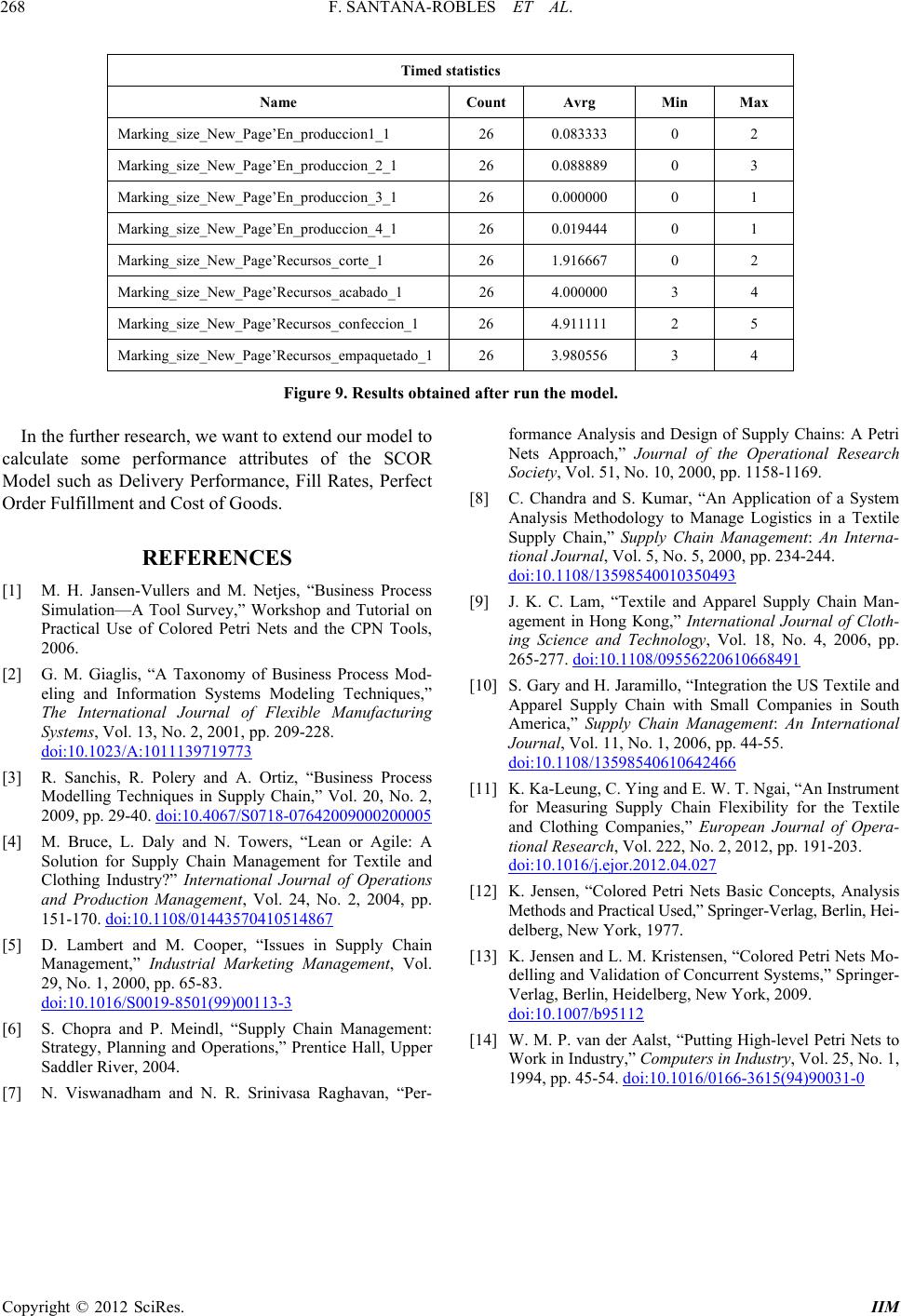
F. SANTANA-ROBLES ET AL.
268
Timed statistics
Name Count Avrg Min Max
Marking_size_New_Page’En_produccion1_1 26 0.083333 0 2
Marking_size_New_Page’En_produccion_2_1 26 0.088889 0 3
Marking_size_New_Page’En_produccion_3_1 26 0.000000 0 1
Marking_size_New_Page’En_produccion_4_1 26 0.019444 0 1
Marking_size_New_Page’Recursos_corte_1 26 1.916667 0 2
Marking_size_New_Page’Recursos_acabado_1 26 4.000000 3 4
Marking_size_New_Page’Recursos_confeccion_1 26 4.911111 2 5
Marking_size_New_Page’Recursos_empaquetado_1 26 3.980556 3 4
Figure 9. Results obtained after run the model.
In the further research, we want to extend our model to
calculate some performance attributes of the SCOR
Model such as Delivery Performance, Fill Rates, Perfect
Order Fulfillment and Cost of Goods.
REFERENCES
[1] M. H. Jansen-Vullers and M. Netjes, “Business Process
Simulation—A Tool Survey,” Workshop and Tutorial on
Practical Use of Colored Petri Nets and the CPN Tools,
2006.
[2] G. M. Giaglis, “A Taxonomy of Business Process Mod-
eling and Information Systems Modeling Techniques,”
The International Journal of Flexible Manufacturing
Systems, Vol. 13, No. 2, 2001, pp. 209-228.
doi:10.1023/A:1011139719773
[3] R. Sanchis, R. Polery and A. Ortiz, “Business Process
Modelling Techniques in Supply Chain,” Vol. 20, No. 2,
2009, pp. 29-40. doi:10.4067/S0718-07642009000200005
[4] M. Bruce, L. Daly and N. Towers, “Lean or Agile: A
Solution for Supply Chain Management for Textile and
Clothing Industry?” International Journal of Operations
and Production Management, Vol. 24, No. 2, 2004, pp.
151-170. doi:10.1108/01443570410514867
[5] D. Lambert and M. Cooper, “Issues in Supply Chain
Management,” Industrial Marketing Management, Vol.
29, No. 1, 2000, pp. 65-83.
doi:10.1016/S0019-8501(99)00113-3
[6] S. Chopra and P. Meindl, “Supply Chain Management:
Strategy, Planning and Operations,” Prentice Hall, Upper
Saddler River, 2004.
[7] N. Viswanadham and N. R. Srinivasa Raghavan, “Per-
formance Analysis and Design of Supply Chains: A Petri
Nets Approach,” Journal of the Operational Research
Society, Vol. 51, No. 10, 2000, pp. 1158-1169.
[8] C. Chandra and S. Kumar, “An Application of a System
Analysis Methodology to Manage Logistics in a Textile
Supply Chain,” Supply Chain Management: An Interna-
tional Journal, Vol. 5, No. 5, 2000, pp. 234-244.
doi:10.1108/13598540010350493
[9] J. K. C. Lam, “Textile and Apparel Supply Chain Man-
agement in Hong Kong,” International Journal of Cloth-
ing Science and Technology, Vol. 18, No. 4, 2006, pp.
265-277. doi:10.1108/09556220610668491
[10] S. Gary and H. Jaramillo, “Integration the US Textile and
Apparel Supply Chain with Small Companies in South
America,” Supply Chain Management: An International
Journal, Vol. 11, No. 1, 2006, pp. 44-55.
doi:10.1108/13598540610642466
[11] K. Ka-Leung, C. Ying and E. W. T. Ngai, “An Instrument
for Measuring Supply Chain Flexibility for the Textile
and Clothing Companies,” European Journal of Opera-
tional Research, Vol. 222, No. 2, 2012, pp. 191-203.
doi:10.1016/j.ejor.2012.04.027
[12] K. Jensen, “Colored Petri Nets Basic Concepts, Analysis
Methods and Practical Used,” Springer-Verlag, Berlin, Hei-
delberg, New York, 1977.
[13] K. Jensen and L. M. Kristensen, “Colored Petri Nets Mo-
delling and Validation of Concurrent Systems,” Springer-
Verlag, Berlin, Heidelberg, New York, 2009.
doi:10.1007/b95112
[14] W. M. P. van der Aalst, “Putting High-level Petri Nets to
Work in Industry,” Computers in Industry, Vol. 25, No. 1,
1994, pp. 45-54. doi:10.1016/0166-3615(94)90031-0
Copyright © 2012 SciRes. IIM